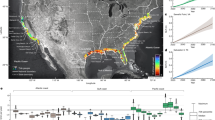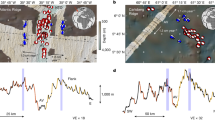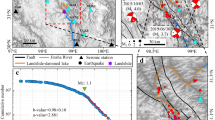Abstract
The destruction caused by the earthquake of 19 September 1985 in Mexico City shows three remarkable features1. First, a (concentration of damage in the former lake bed; second, a peculiar distribution of high- and low-damage areas alternating within a few city blocks, and third, a selectivity for buildings between five and fifteen storeys high. While the last point is understood by civil engineers2 and the first confirms the relevance of the soft ground, the second feature is the most puzzling. To a physicist such a pattern evokes the idea of a standing wave, with low- and high-damage areas corresponding to nodes and antinodes. This suggests a resonance phenomenon of the waterlogged ground moving collectively. From the Navier equations of classical elasticity, it is known3 that a transfer of the incoming seismic-wave energy to longitudinal waves takes place if a sharp change from hard to soft ground exists. Solving then the two-dimensional Poisson equation for the longitudinal waves within the ancient lake boundaries, we show that for the observed seismic wave period of 2 s, a standing-wave solution exists which explains qualitatively the damage distribution pattern.
This is a preview of subscription content, access via your institution
Access options
Subscribe to this journal
Receive 51 print issues and online access
$199.00 per year
only $3.90 per issue
Buy this article
- Purchase on Springer Link
- Instant access to full article PDF
Prices may be subject to local taxes which are calculated during checkout
Similar content being viewed by others
References
Información Científica y Tecnológica Vol. 7, no. 110 (Consejo Nacional de Ciencia y Tecnología, México, 1985).
Anderson, I. New Scient. 108, 32–33 (1985).
Ewing, W. M., Jardetsky, W. S. & Press, F. Elastic Waves in Layered Media 74–124 (McGraw-Hill, New York, 1957).
Marsal, R. J. & Mazari, M. The Subsoil of Mexico City (UNAM, México, 1959).
Marsal, R. J. in International Clay Conference, Report E16 (Instituto de Ingenieria, UNAM, México, 1975).
Hiriart, F., Marsal, R. J. & Rosenblueth, E. Ingenieria 28, 1–34 (1957).
Reséndiz, D. et al. Inst. Ingen. UNAM, Report No. 276 (1970).
Prince, J. et al. Inst. Ingen. UNAM, Report No. IPS-10A (September 20, 1985).
Mena, E. et al. Inst. Ingen. UNAM, Report No. IPS-10B (September 21, 1985).
Quaas, R. et al. Inst. Ingen. UNAM, Report No. IPS-10C (September 23, 1985).
Jaime, A. Archivo de Edificios Dañados por los Sismos del 19 y 20 de Septiembre 1985 en la Ciudad de México (Sección de Geotermia II UNAM, México, 1985).
Manzanilla, L. Report Inst. Invest. Antrop. UNAM 1, 1–8 (1986).
Landau, L. D. & Lifshitz, E. Theory of Elasticity (Pergamon, London, 1959).
Aki, K. & Richards, P. G. Quantitative Seismology (Freeman, Berkeley, California, 1980).
Kolsky, H. Stress Waves in Solids (Dover, New York, 1983).
Love, A. A Treatise on the Mathematical Theory of Elasticity (Cambridge University Press, 1892).
Leet, L. Earth Waves (Harvard Univ. Press, Cambridge, 1950).
Martinez, B., León, J. L., Rascón, O. I. & Villareal, A. Inst. Ingen. UNAM, Report No. 338 (1974).
Neuberger, B. & Noid, D. W. Report of the Oak Ridge National Laboratory (ORNL, Tennessee, 1983).
Author information
Authors and Affiliations
Rights and permissions
About this article
Cite this article
Flores, J., Novaro, O. & Seligman, T. Possible resonance effect in the distribution of earthquake damage in Mexico City. Nature 326, 783–785 (1987). https://doi.org/10.1038/326783a0
Received:
Accepted:
Published:
Issue Date:
DOI: https://doi.org/10.1038/326783a0
This article is cited by
-
Ground Motion Parameters and Resonance Effect During Strong Earthquake in Northern Thailand
Geotechnical and Geological Engineering (2021)
-
Active vibration control of seismic excitation
Nonlinear Dynamics (2018)
-
Seismic response of the Mexico City Basin: A review of twenty years of research
Natural Hazards (2007)
-
Earthquake damage in Mexico City
Nature (1987)
-
Basin-ring spacing on the Moon, Mercury, and Mars
Earth, Moon, and Planets (1987)
Comments
By submitting a comment you agree to abide by our Terms and Community Guidelines. If you find something abusive or that does not comply with our terms or guidelines please flag it as inappropriate.



